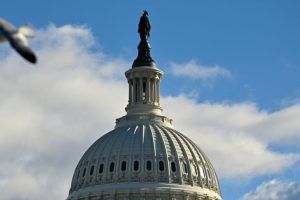The regulations to expel migrants created during the Donald Trump era, caused by the Covid-19 health situation, will be repealed on May 11, but it does not mean an opening of the border for the flow of migrants. On the contrary, it opens a new stage of regulations. The Government of Joe Biden will form processing centers and regulations for family members of residents. In addition, Title 8 will enter into force, which restricts the possibility of asylum for five years to those who enter the country irregularly.
As the days go by and the end of Title 42 approaches, the uncertainty and despair of thousands of foreign citizens who intend to reach the United States grows. This legislation, implemented during the government of Donald Trump in the framework of efforts to prevent the spread of Covid-19, will end on May 11.
In this context, the Joe Biden Administration continues to announce and build new legal figures to manage migratory flows that, far from decreasing, continue to escalate.
The last days of Title 42 have generated incidents on the southern border, which connects with Mexico and is the “gateway” for all migrants from Latin America. Last Wednesday, May 3, in Tapachula, there were problems after hundreds of people gathered trying to obtain the necessary documents to advance to the United States.
States also advance their own measures. This Monday, May 8, the governor of Texas, Greg Abbot, announced the deployment of a special force to prevent the entry of undocumented people into the country.
“Texas is doing more than any state in US history to defend our border. That includes deploying up to 10,000 members of the National Guard and 1,200 soldiers from the Texas Department of Public Safety,” the official said.
France 24 contacted Guillermo Pacheco, immigration analyst, who explained the positive consequences that Washington could obtain with the termination of the effects of Title 42.
“The United States will benefit from being able to apply actions that limit the migratory flow, based on the latest that this Administration presented: increase resources on the southern border, increase efficiency in processing, impose consequences on those who enter the country illegally, reinforce the facilities of non-profit organizations, go after human traffickers and collaborate with international partners,” says Pacheco.

However, the culmination of this regulation does not mean that getting to the US is easier. On the contrary, the possibilities could be more complex: when Title 42 expires, the prosecutions of people will take place in accordance with Title 8, which has more severe sanctions, including the opening of possible criminal cases and even a veto to re-enter the system. country of at least five years.
The Secretary of National Security, Alejandro Mayorkas, expressed the intention to expedite the expulsions of those who do not comply with the necessary procedures, increasing the speed to clear the border. He even added that asylum officers and immigration judges were sent to the crossing between the two countries.
Other measures that had disappeared from the picture returned. The telephone booths so that the dialogue with the anti-immigration lawyers is more fluid were placed again. Something that had happened during Trump’s term, but eliminated since Biden’s inauguration.
On the other hand, there will be a greater number of deportation flights to some destinations and the detention capacity of adults has been expanded. A sign that the United States intends to combat access to its territory.
The Mexican Foreign Ministry, Marcelo Ebrard, reacted to the decisions of the US government, which have an effect in the Latin American region.
“They told us that they would take measures according to their laws to keep what is working for ‘Title 42’, but using other legal instruments because people are being deceived by telling them that they will be able to go to the United States from May 11,” express.
From Washington they have advanced on new methods in different countries with the aim of controlling the displacement of civilians and avoiding long migratory journeys.
Close cooperation with Mexico
After the visit of the national security adviser of the United States, Elizabeth Sherwood-Randall, the White House announced on May 2 what the new methodologies will be like with the neighbor to the south, with whom they aim to create more cooperative ties to cover a phenomenon that affects both nations.
The Washington-Mexico City pairing will aim to expand the legal avenues available to Central American countries. In addition, they reaffirmed the commitment to combat people smugglers on the shared border, just as they will do in the Darién Gap —between Colombia and Panama—, where criminal groups operate.

While the Administration of Andrés Manuel López Obrador promised to support the regional processing centers announced by the United States, contributing to their operation and welcoming people for humanitarian reasons.
Lastly, they also aim to modernize the 2,000 miles (more than 3,000 kilometers) they share to expand the Calexico East Land Port of Entry before the end of 2023.
Regional Processing Centers
Among the new provisions that the United States will implement is the installation of regional processing centers in different countries with the purpose of decongesting the agglomeration of migrants that hit the borders.
In theory, this figure seems auspicious for having virtues such as avoiding the transit of migrants on foot moving across the continent. A benefit that would also fall on Mexico, a country that welcomes all civilians who are rejected.
At the moment, the first centers announced will be in Colombia and Guatemala, while talks with other states —especially in Latin America— to establish more are ongoing, Mayorkas acknowledged.
The processing centers, operated by “international partners”, will act as administrative filters, where thousands of immigrants will be interviewed every month to verify if they meet the requirements of the US refugee program, as well as labor and humanitarian conditions.

The Secretary of State, Antony Blinken, also added in a conference with Mayorkas that both Canada and Spain showed their willingness to receive migrants who go through these procedures.
However, the improvements for Mexico are closely conditioned on whether what is on paper about the operation of these centers is really effective.
“If they work so that migrants do not reach the southern border, it can be an improvement so that the migratory flow does not grow, but, otherwise, that flow will be greater because the actions of the United States will increase to prevent entry as much as possible of immigrants,” explains Pacheco.
family reunification
The US government also intends to expand the family reunification program that exists only for Cuba and Haiti. Now it will be implemented for El Salvador, Guatemala, Honduras and Colombia.
Those systems allow migrants with family petitions for permanent residency to enter the territory on temporary humanitarian parole while their applications are being processed and their visas are confirmed.
The United States ratified its commitment to shelter up to 100,000 people from Honduras, Guatemala and El Salvador under the name of family reunification.
In another aspect, Mayorkas explained that they are working on a new regulation that prevents reception for all those migrants who have not processed the right to asylum or have protection in another country.
This will need to be done at an official port of entry, using the much-maligned CBP One app as the method of making an appointment. The few number of shifts available, the poor operation of the system and the technical problems are some of the complaints that hundreds of migrants have expressed.
Activists in favor of the rights of immigrants highlighted the implementation of the processing centers and the expansion of the family reunification program, but expressed their concern regarding the speeding up of asylum procedures, alleging that it could favor a greater number of deportations. wrong.
With AP and local media





![[Img #74676]](https://thelatestnews.world/wp-content/uploads/2024/12/Laser-artificial-neuron-150x150.jpg)








